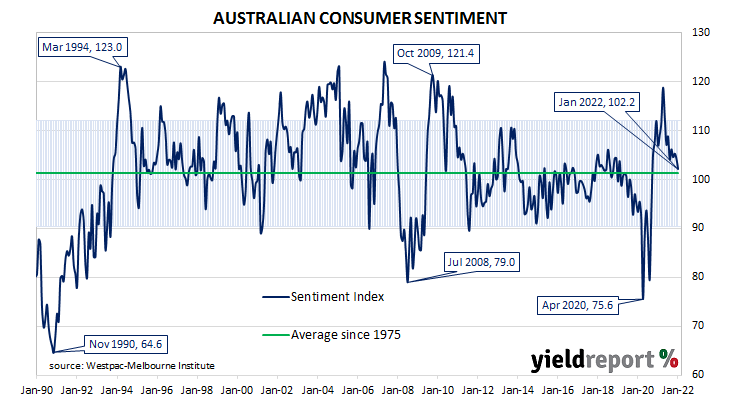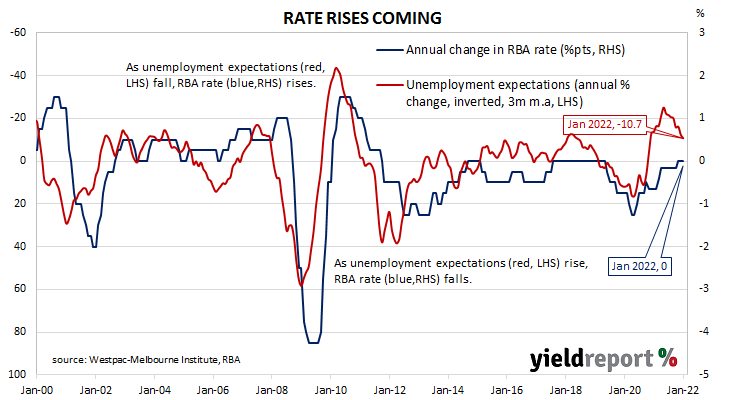Summary: Household sentiment deteriorates mildly in January; “surprisingly solid result” given omicron spread; still above long-term average; states impacted by ‘delta’ lockdowns “less unsettled” than other states; three of five sub-indices lower.
After a lengthy divergence between measures of consumer sentiment and business confidence in Australia which began in 2014, confidence readings of the two sectors converged again in mid-July 2018. Both readings then deteriorated gradually in trend terms, with consumer confidence leading the way. Household sentiment fell off a cliff in April 2020 but, after a few months of to-ing and fro-ing, it then staged a full recovery.
According to the latest Westpac-Melbourne Institute survey conducted in the week beginning 10 January, household sentiment has again deteriorated mildly. Their Consumer Sentiment Index declined from December’s reading of 104.3 to 102.2, maintaining a run of slightly-above average readings.
“This is a surprisingly solid result given the rapid spread of the omicron COVID variant over the last month,” said Westpac Chief Economist Bill Evans. “The 2% decline compares to the 5.2% drop seen in the first month of the delta outbreak in New South Wales, a 6.1% drop heading into Victoria’s ‘second wave’ outbreak in 2020 and the epic 17.7% collapse when the pandemic first hit in early 2020.”
Any reading of the Consumer Sentiment Index above 100 indicates the number of consumers who are optimistic is greater than the number of consumers who are pessimistic. The latest figure is still slightly above the long-term average reading of just over 101.
Domestic Treasury bond yields increased moderately on the day. By the close of business, the 2-year ACGB yield had gained 4bps to 1.42%, the 10-year yield had added 5bps to 2.03% while the 20-year yield finished 4bps higher at 2.52%.
In the cash futures market, expectations of any material change in the actual cash rate, currently at 0.05%, remained fairly soft until May. At the end of the day, contract prices implied the cash rate would not exceed the RBA’s 0.10% target rate until April 2022 and then rise to 0.31% by June. February 2023 contracts implied a cash rate of 1.18%.
“Consumers in states impacted by ‘delta’ lockdowns appear to have been less unsettled by the rapid spread of the omicron variant than those in states experiencing their first major wave of COVID infections,” noted Evans. New South Wales and Victoria recorded increases in their respective sentiment indices whereas the readings for Queensland, Western Australia and South Australia all fell.
Three of the five sub-indices registered lower readings, with the “Economic conditions – next 12 months” sub-index posting the largest monthly percentage loss. Readings for the sub-indices “Family finances versus a year ago” and “Time to buy a major household item” both improved.
The Unemployment Expectations index, formerly a useful guide to RBA rate changes, rose from 104.1 to 112.7. Higher readings result from more respondents expecting a higher unemployment rate in the year ahead.



